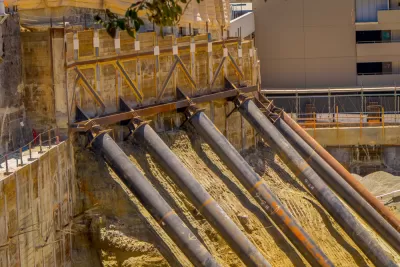New research reveals an "unseen force" in the housing crisis: consolidation of home building capital and land ownership.

"U.S. housing debates rarely involve the 'O' word. But oligopolies, a cousin of monopolies in which a few powerful players corner the market, are emerging everywhere," writes Andrew Van Dam.
Van Dam is sharing the results of a working paper by Luis Quintero and Jacob Cosman of Carey Business School at Johns Hopkins, which found a 25 percent drop in the number of firms operating in most housing markets.
The trend has consequences for housing affordability. "With fewer competitors, builders are under less pressure to beat out rival projects, and can time their efforts so that they produce fewer homes while charging higher prices," according to Van Dam. "From 2013 to 2017 home prices grew more than twice as fast as they would have if the market hadn’t consolidated, the economists found."
The article includes a lot more about the methodology of the study, infographics to illustrate the findings, and a big caveat about the role of consolidation in the complex mix of factors driving up prices: the costs of labor and materials, restrictive land use regulations, and other commonly cited factors are still responsible for the housing crisis. And housing and land costs "could be a cause of consolidation, not an effect," explains Van Dam.
FULL STORY: Economists identify an unseen force holding back affordable housing

Alabama: Trump Terminates Settlements for Black Communities Harmed By Raw Sewage
Trump deemed the landmark civil rights agreement “illegal DEI and environmental justice policy.”

Planetizen Federal Action Tracker
A weekly monitor of how Trump’s orders and actions are impacting planners and planning in America.

The 120 Year Old Tiny Home Villages That Sheltered San Francisco’s Earthquake Refugees
More than a century ago, San Francisco mobilized to house thousands of residents displaced by the 1906 earthquake. Could their strategy offer a model for the present?

In Both Crashes and Crime, Public Transportation is Far Safer than Driving
Contrary to popular assumptions, public transportation has far lower crash and crime rates than automobile travel. For safer communities, improve and encourage transit travel.

Report: Zoning Reforms Should Complement Nashville’s Ambitious Transit Plan
Without reform, restrictive zoning codes will limit the impact of the city’s planned transit expansion and could exclude some of the residents who depend on transit the most.

Judge Orders Release of Frozen IRA, IIJA Funding
The decision is a victory for environmental groups who charged that freezing funds for critical infrastructure and disaster response programs caused “real and irreparable harm” to communities.
Urban Design for Planners 1: Software Tools
This six-course series explores essential urban design concepts using open source software and equips planners with the tools they need to participate fully in the urban design process.
Planning for Universal Design
Learn the tools for implementing Universal Design in planning regulations.
Clanton & Associates, Inc.
Jessamine County Fiscal Court
Institute for Housing and Urban Development Studies (IHS)
City of Grandview
Harvard GSD Executive Education
Toledo-Lucas County Plan Commissions
Salt Lake City
NYU Wagner Graduate School of Public Service





























